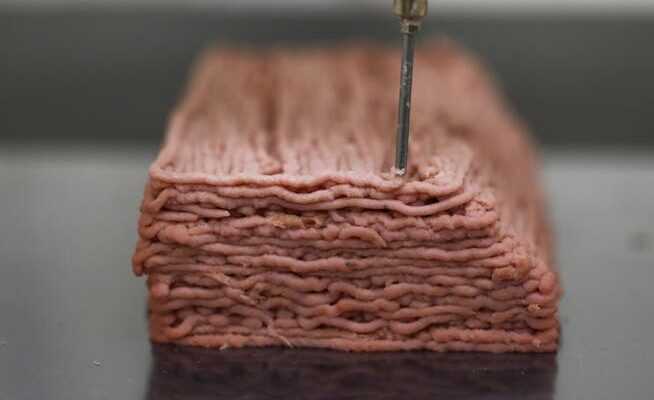In a study, scientists compare the negative effects of different forms of nutrition on the climate, land and water. Result: Everything is better than today’s habits.
According to a study, animal-free meat from the 3D printer, like here from the Israeli start-up Redefine Meat, is the better choice than conventional animal products.
A cow in the meadow: Many people in this country perceive that as “natural”. Opinions differ as to whether the meat from cows and the milk that they buy in the supermarket has anything to do with nature. But many are likely to be far less skeptical about them than meat or milk produced in a test tube or Petri dish. Scientists have now calculated that a diet with food from the laboratory, despite its perceived “unnaturalness”, is far more environmentally friendly than one with animal products. You now have your results in the Trade journal «Nature Food» published.
Can novel foods provide all the nutrients?
While meat and milk from the laboratory only slowly trickle out of the test kitchens, which are often located in Silicon Valley, into the rest of the world, food made from insects has long been available in supermarkets in Switzerland. Mycoprotein – fermented mushroom protein – has also been around for 20 years; it is on the shelves of the major retailers under the brand names Quorn, Délicorn and Cornatur.
The scientists from Finland count these and other foods among the “novel and future foods” (NFF) that they included in their study. They not only wanted to identify the potentially most environmentally friendly diet, but also to find out whether NFF can replace all animal-based foods without missing out on essential nutrients.
As a reference, they used today’s average eating habits of people in Europe. With these, they compared three optimized diets: vegan, omnivorous, and NFF-based. In all four cases, they examined the impacts in the areas of land use, water consumption and global warming potential.
80% less negative environmental impact
The result: Compared to current diets, the “optimized omnivore diet” with less consumption of animal foods would reduce the effects in all three areas by about 80%. It performs just as well as the “optimized vegan diet”. According to the calculations, the most environmentally friendly diet that ensures a supply of all nutrients is one without animal foods but with NFF – the difference, however, is a few percentage points.
The foods with the best balance between nutritional content and environmental impact are insect meal, milk from cell cultures and myco- or single-cell protein. The advantage of these NFFs over animal-based foods lies in their greater efficiency in terms of land and water use. They are superior to protein-rich plant foods such as legumes, nuts, tofu, meat substitutes or plant-based milk because they can contain a more comprehensive range of nutrients, such as protein, calcium, vitamin B12 or omega 3 fatty acids. In addition, vitamins and minerals could – and would have to – be added to them, the researchers write.
Meat consumption has by far the greatest impact on the environment. The fact that the omnivore and the vegan variant are equal is only possible because the proportion of animal-based foods in the “optimized omnivore diet” calculated by the scientists has fallen to almost zero. Because this does not seem realistic, the scientists calculated another option: an omnivorous diet with 20 percent of the current amount of meat, fish, eggs and dairy products. The environmental impact is then still around 70 percent lower than with the current diet, and water consumption is almost 80 percent lower.
Energy consumption is not included
However, others view the scientists’ calculations with reservations: “Especially for novel foods that are still in development – such as milk from cell cultures – there are major uncertainties with regard to the environmental impact,” says Florian Humpenöder from the Department of Transformation Pathways at the Potsdam Institute for Food and Drug Administration Climate Impact Research (PIK). “One key factor is energy consumption. Because instead of feeding animals, which then provide milk and meat, cellular agriculture requires more energy in the production process, for example to heat bioreactors.” As is so often the case, climate-friendliness also depends on whether there is a low-carbon source for the energy required.
Humpenöder’s current colleague Franziska Gaupp, visiting scientist in the Department of Climate Resilience at PIK, also criticizes the lack of an energy balance. And she complains that the study only emphasizes the positive health effects of cultured meat. “She forgets that the effects depend on the composition of the final products. For example, many vegetarian burgers that are currently on the market have a high salt content and thus have negative health effects,” says Gaupp.
Despite all the limitations, a few general, unsurprising but very simple pieces of advice can be derived from the results: If you want to eat more environmentally friendly – and healthier – you should eat a lot more legumes, nuts and vegetables and much less animal foods and less starchy roots and eat tubers. The potential is huge and there is no compromise on naturalness, familiarity, taste or price. The NFFs can then satisfy the additional nutritional needs – and curiosity – if necessary.
